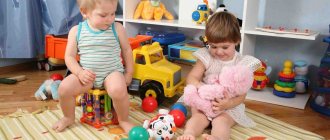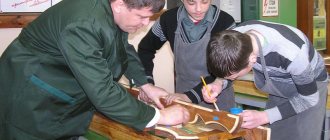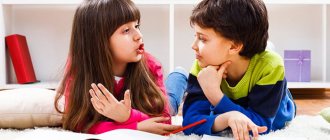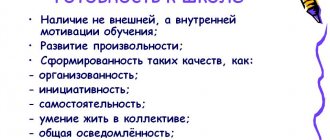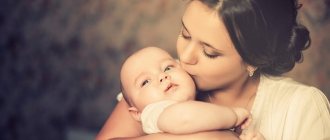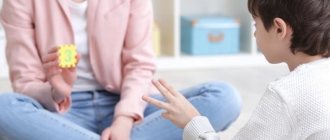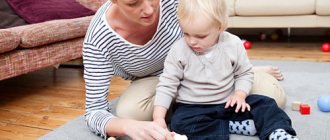Social situation of development of young children
One of the main achievements of a two-year-old child is walking. It allows him to become more independent and provides more opportunities to explore the surrounding space. As a rule, by the age of three, the child’s coordination of movements becomes much better, they can carry out various complex actions. During this period, the child can already wash himself, climb on various objects to get something, jump, etc. In other words, at this age the child already feels the rhythm of movements quite well.
Are you an expert in this subject area? We invite you to become the author of the Directory Working Conditions
In infancy, children exhibit certain neoplasms, which subsequently lead to changes in the relationship between them and adults. The result is the formation of a new social situation: joint activity appears between the child and the adult, which over time becomes objective. The essence of such activity is that the child learns the ways of using certain objects developed in society. In other words, the child learns from the adult how to use the surrounding objects. An adult, in turn, must explain to him why such items are necessary and how they can be used.
Note 1
Thus, in early childhood, a child’s social development situation is a triad: “Child - object - adult,” with the most important thing for children being the object.
An example is the process of play in children. If you watch them, you will notice that children playing with any toy (car, doll, etc.) constantly look at it. Often, the observer has the feeling that, apart from this object, the child is not interested in anything else, since all his attention belongs entirely to this toy. However, this is not true. It is the adult who must teach the child to use various objects in his life.
Finished works on a similar topic
Course work Leading activity in early childhood 480 ₽ Abstract Leading activity in early childhood 280 ₽ Test paper Leading activity in early childhood 210 ₽
Receive completed work or specialist advice on your educational project Find out the cost
Thus, during early childhood, the child’s activity becomes objective, since its entire meaning lies in some object, as well as in the way it is used. The child’s communication also becomes associated with the organization of objective activities. As a rule, this allows it to develop intensively and quite quickly from a form of organizing activity it becomes speech. It should be noted that such communication is not only emotional, but also situational and business-related, since it is mediated by a word that has an objective reference.
Parenting in the first month of life
You should start training your baby from a very early age. It is important to remember that before one year, all the foundations for its further development are laid. Already at this stage, the child understands and perceives a lot: he reacts to sounds around him, determines the tone of conversation, melodies, distinguishes light from darkness, recognizes by smell that his mother is somewhere nearby, and feels all touches.
The child has well-developed innate reflexes, for example, he looks for his mother’s breast, sucks it, flinches from too loud or sudden sounds, walks with his legs, if you lift him and hold him in an upright position, grabs with his hands.
During this period of time, education should consist of simple methods. Develop color vision by placing bright rattle toys at a distance of about 30 centimeters from the child’s eyes. Teach gaze fixation by moving a bright toy in front of the child’s eyes at a distance of 20 centimeters, and then, after waiting for the gaze to fixate on it, move it to the other side and in the vertical direction. Form the baby's hearing by talking to him in a quiet and calm voice, turning on music and rattling rattles.
Experts also recommend carrying your child around the house, telling him about the objects around him and sharing interesting stories.
Second direction along Elkonin
Another direction in the scientist’s research is the study of the characteristics of children’s orientation in the area of mastered action. Elkonin examined in detail the three stages of formation of the leading type of activity at an early age. The psychology of the child is clearly visible at each stage, and the changes occurring in it are studied.
Thus, at the beginning of the first stage, the child manipulates an object, unaware of its purpose. Gradually he learns to perform the correct actions with it, but practical skills are not yet sufficiently developed. The baby understands that the spoon must be brought to the mouth, but cannot hold it horizontally. At the end of this stage, the child masters a specific way of acting with objects. A hard connection is established in his head. Children cannot use the studied item for other operations (drink from a cube, wipe the table with a handkerchief).
At the second stage of development, the child begins to reproduce mastered actions in non-standard situations. Transfer can be carried out to other objects (you can drink not only from a cup, but also from a glass) and situations (trying to dress a cat).
The third stage is marked by the appearance of game action. The child independently decides which operations are suitable for objects. He masters substitution. Now the cube can be an iron, a piece of bread, or soap. The candy will be replaced by a plasticine ball or pebble. In fact, kids are introduced to the first elementary symbols. This creates the preconditions for the development of imagination.
Definition and age periodization
The term “leading activity” was introduced into psychology by Vygotsky. This concept began to be understood as such activity, the development of which leads to the formation of the main psychological new formations at a given stage of personality development. For example, for a preschooler, role-playing game turns out to be the most important. With the transition to the next stage of psychological development, the leading activity changes, as the child develops new needs.
On this basis, an age periodization was compiled. It outlines the following stages:
- Infancy. Up to one year old, infants need emotional communication with adults.
- Children 1-3 years old. The leading type of activity at an early age is actions with objects.
- Preschool childhood. Role-playing games come to the fore for children aged 3-7 years.
- Younger schoolchildren (from 7 to 11 years old) are involved in educational activities.
- For teenagers from 11 to 15 years old, personal communication with friends becomes extremely important.
- Boys and girls aged 15-18 are busy with professional self-determination.
Second month of life
Communication is the leading activity of infancy. Physical contact with parents is additionally added to communication. The child needs to be given a feeling of security and closeness, carried in his arms, massaged, smiling and trying to evoke a response.
In the second month of life, parental education continues to focus on the development of vision and hearing. Objects for study are already placed at a distance of 30 to 50 centimeters. The sounds to learn become multifaceted.
In order to develop tactile sensitivity, the baby needs to be given toys and objects of different shapes. So that the child can hold his head independently in the future without any problems, they begin to roll a bright ball in front of him. The baby will watch him closely, thereby tensing his neck muscles.
Fourth month of life
At the fourth month, the baby can already hold his head independently, can gesture well with his legs and arms, examines objects around him, and rolls over from his back to his tummy. At this time, he not only looks at objects, but also sees them. Perceives voices and sounds around. Feels the need for her mother not only to study herself, but also everything around her.
The parent must monitor the baby’s daily routine and adjust it if necessary. At 3-4 months, the average baby needs 15 hours of sleep. 10 hours are at night, and the rest are distributed evenly throughout the day.
If adults have decided that the child should sleep only in his own bed, then he should only be placed there, thereby instilling discipline and habit.
Features of education in the fifth month
The child not only hums, but also makes clearly distinguishable sounds. Seeing a toy nearby, he can touch it and also hold it firmly in his hands. He continues to perceive all things by taste and tactile sensations.
The child’s muscles and limbs have already become stronger, which gives him the opportunity to rise on his hands, stretch his legs and even get on all fours. It is important for the parent to continue to maintain as much physical contact with the infant as possible.
It is important to carry the child in your arms, talk to him often, respond to his sounds, and smile back. It will also be good to develop a sense of rhythm in the baby; for this, massage and gymnastics with counting and dancing to music should be done.
The child is very happy when he sees that he is happy. He shows emotions in different ways: he is capricious and cries to show discomfort, or he laughs and plays when he is having fun. It is important to remember that when crying loudly, the child is not manipulating his parents, but is simply showing his needs or dissatisfaction, since he does not yet know how to do this in any other way.
Emergence of other activities
Through manipulations with objects, the baby becomes involved in new relationships. The leading activity of a young child creates the prerequisites for the emergence of:
- Labor activity. The baby is interested in using a broom, wiping dust with a rag, watering flowers with a watering can, and making cookies from dough. Not all parents are ready to patiently teach their child these skills. If a child is removed from household chores, his self-esteem decreases and his motivation to work disappears.
- Gaming activity. First, the child manipulates the toys, repeating the movements of the mother: feeding the bear, rocking the doll. He doesn’t depict anything yet, but simply copies. Gradually the imagination develops. By the age of 3, children are able to reproduce the real actions of adults with the help of toys and substitute objects. At the same time, during the game the child comes to an awareness of the role he plays (cook, mother, hairdresser, driver).
- Productive activities (drawing, modeling). Initially, the baby simply explores the material, learns to scribble with a pencil, without trying to depict something meaningful. The turning point comes when he begins to guess real objects behind random shapes and lines. The kid first applies the strokes, and then joyfully looks for what happened. With the participation of an adult, he develops a desire to deliberately depict some light images.
Development of subject activity
A small child does not immediately understand the purpose of toys and things around him. It all starts with the first phase of development of the leading type of activity. At an early age, these are any actions with objects arising from their properties. Pencils can be rolled, thrown, licked, or tapped like drumsticks. Children act as experimenters.
Then comes the second phase, when the child learns the true purpose of the object and uses it in the usual way. The kid takes a pencil when he wants to draw. And finally, the turn of the third phase comes. The child masters the free use of an object, while constantly remembering its main function. So, playing doctor, the baby can use a pencil instead of a thermometer.
Is everything so clear?
Most psychologists and teachers recognize the existence of a single leading type of activity at an early age. However, there are also opponents to this theory. They protest against generalization at any age. Leites pointed out that the concept does not take into account the personality of a particular child, his individual characteristics. Rubinstein, without denying the importance of games, named another important activity that determines the development of any preschooler: household activities. Imperceptibly, through everyday activities, the baby learns the rules of behavior and learns to communicate with peers.
Petrovsky doubted that it was possible to determine the leading type of activity of children. At an early age, they are especially susceptible to the influence of their environment. Therefore, different children may lead different types of activities depending on the level of development and social situation.
